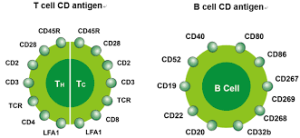 The cluster of differentiation or cluster of designation or classification determinant, which is often abbreviated as CD is a protocol used for the identification and investigation of cell surface molecules providing targets for immunophenotyping of cells.
The cluster of differentiation or cluster of designation or classification determinant, which is often abbreviated as CD is a protocol used for the identification and investigation of cell surface molecules providing targets for immunophenotyping of cells.
CD molecules can act as receptors or ligands, the molecule that activates a receptor, important to the cell.
A signal cascade is usually initiated, altering the behavior of the cell.
Some CD proteins play a role in cell signaling, and others have function in cell adhesion.
CD for humans is numbered up to 371, withunique clusters and subclusters having been identified.
The surface molecule is assigned a CD number once two specific monoclonal antibodies(mAb) are shown to bind to the molecule.
If the molecule has not been well-characterized, or has only one mAb, it is usually given the provisional indicator “w” (as in “CDw186”).
Cell populations are usually defined using a ‘+’ or a ‘-‘ symbol to indicate whether a certain cell fraction expresses or lacks a CD molecule.
CD34+, CD34- the former expresses CD34 and the latter does not.
Some cell populations can also be defined as bright, mid or dim, indicating an variability in CD expression.
The CD system is commonly used as cell markers in immunophenotyping, allowing cells to be defined based on what molecules are present on their surface.
CD rkers are often used to associate cells with certain immune functions.
CD molecules are utilized in cell sorting including flow cytometry.
stem cells CD34+, CD31-, CD117
all leukocyte groups CD45+
Granulocyte CD45+, CD11b, CD15+, CD24+, CD114+, CD182+
Monocyte CD4, CD45+, CD14+, CD114+, CD11a, CD11b, CD91+,[16] CD16+
T lymphocyte CD45+, CD3+
T helper cell CD45+, CD3+, CD4+
T regulatory cell CD4, CD25, and Foxp3
Cytotoxic T cell CD45+, CD3+, CD8+
B lymphocyte CD45+, CD19+, CD20+, CD24+, CD38, CD22
Thrombocyte CD45+, CD61+
Natural killer cell CD16+, CD56+, CD3-, CD31, CD30, CD38
Two commonly used CD molecules are CD4 and CD8, which are, in general, used as markers for helper and cytotoxic T cells, respectively.
These molecules are defined in combination with CD3+, as some other leukocytes also express these CD molecules (some macrophages express low levels of CD4; dendritic cells express high levels of CD8).
CD47 has anti-phagocytic signals to macrophages and inhibits natural killer (NK) cells.
